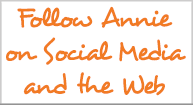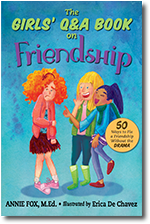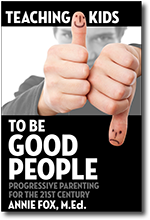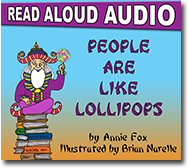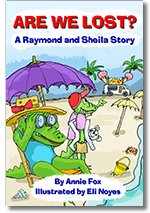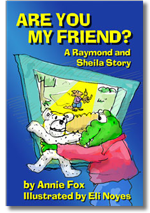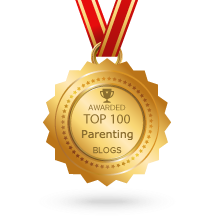|
|
September 19, 2012
Aside from giving birth to my own children, nothing provides me with more delight and a creative high than producing a new book. To find out why I decided, after 25 years of writing exclusively for kids, to write a book for adults, and why every parent and educator at least ought to explore Teaching Kids to Be Good People, please read the introduction.
____________
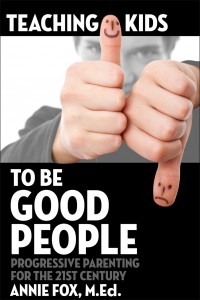 The book I've been working on for 15 years
Obviously not all teachers are parents, but all parents are teachers. That’s convenient because good character traits, like empathy and respect, are teachable skills that need to be learned at home as well as at school. When we teach kids to be good people we help the world become a safer, saner, more equitable place for all of us. Nothing is more important than that!
But these are tough times for character educators. I know because I’ve been working in schools with students, teachers, and parents for more than 30 years as well as online since 1997. The job is getting harder. The values promoted by mass media work against us. What passes for entertainment is frequently mean-spirited. Character assassination in public discourse is the air we breathe, and the resulting pollution is a hazard to our well-being. It’s a huge problem, but what can we do?
When our kids plug in, which is most of the time, they encounter few positive adult role models. Online and off, our culture frequently ignores or rewards cruelty. This is why our children desperately need us to do a better job mentoring them in the direction of respect and kindness.
Our kids are good kids, but they are constantly challenged by the less-than-compassionate standards of their peers with whom they are mind-linked 24/7. Today’s teens suffer from status anxiety at levels no other generation has endured. This compels them to do whatever it takes to fit in, including things they are not particularly proud of. Despite these ubiquitous challenges I am confident we can teach our kids to be good people who actively seek opportunities to help others and who have the social courage to act on their good intentions.
We parent-educators are gardeners. We plant seeds and offer nurturing lessons that our kids can internalize. But we are not our children’s only influencers. By rededicating ourselves to teaching our kids to be good people, we provide them with the tools to do the right thing while we’re right there beside them and when they’re on their own. Whether they actually do it, is their choice. But at least we’ll know we’ve done our part well.
To help on our parenting journey, I’ve written this very personal and pragmatic guide that includes essays, podcasts, prompts, tools, questions, answers, and self-assessment quizzes all for the purpose of teaching kids to be good people.
How do you define a “good person?” That’s what I wanted to find out, so I crowdsourced the answer by posting the question. I received hundreds of responses. Eight concepts kept reappearing: Emotional intelligence, ethics, help, forgiveness, compassion, empathy, acceptance, and social courage—all essential, teachable skills. This book will help you teach them to your children or students. Hopefully, we’ll become so engaged in this process that we will inspire all of our children to become part of the solution.

April 10, 2012
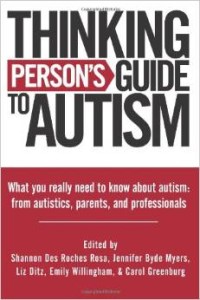 For parents with kids with autism by parents with kids with autism It’s Autism Awareness/Acceptance Month. Excellent, because we all need more awareness and education in this area. I know I sure do. That’s why, a few weeks ago, I interviewed Shannon Des Roches Rosa, self-described “Potty-mouthed Mom” behind the blog, Squidalicious: Parenting, Autism, iPads and Geekery. Shannon’s been writing about her autistic son, Leo, and her parenting journey since 2003. She writes with a level of honesty and humor that grabs me and keeps me coming back. She talks that way too. Here’s an excerpt from our hour-long conversation about her new book The Thinking Person’s Guide to Autism.
Annie: There seem to be new books on autism coming out every week. Why did you and your co-editors (Jennifer Byde Myers and Liz Ditz) feel the need to produce yet another one?
Shannon: None of them were books we would have wanted when our kids were first diagnosed. That is, a rational, compassionate handbook that would say: What is autism? Tell me everything I need to know. What are my next steps? And how can I make good decisions? There are so many competing approaches out there. Some of them are useless at best. Others are actively harmful, like chelation, a medical procedure for removing metals from the body. And a lot of these treatments are so disrespectful to people with autism – treating them as if they’re ‘broken’ and not ‘whole’ people. And some are just so expensive for parents who don’t necessarily have a lot of money to take out a second mortgage to “cure” their child with an approach that doesn’t even have a basis in mainstream science.
Annie: What struck me from reading several of the essays in the book (there are about 50 and each is a gem), were descriptions of that parental roller coaster ride of hope and expectations, pursuing some of these treatments, followed by frustration and despair.
Shannon: In many cases, all of it for naught. What we try to do in our book is help people learn to think critically and rationally about autism even when they are in the midst of this whirlwind of new information. So many parents are so distraught when they learn their child is diagnosed with autism. We want to help them through that. And we want to let them know that even though the media tends to perceive people with autism and special needs like this lightning bolt of ‘bad luck,’ people with special needs are part of our community. They’ve always been here. This is just another way of being. These people need more understanding. Yes! They need more support. Yes! But that doesn’t make them “other” or “less than.” These are families that need compassion and understanding, but not pity. We want to help people get past fear, myths and negative stereotypes.
Annie: I just want to say, as a writer myself, that I’m a very critical reader. And in addition to the excellent information you’ve provided in The Thinking Person’s Guide to Autism, it is a wonderfully written book. It’s very readable and the tone is very reassuring. And if your goal was to share the voices of real people talking about autism with the authority of their personal experience, you have exceeded that goal. I hope you’re very proud of what you’ve accomplished. I also hope that the millions of people whose lives are touched by autism (that includes family, friends and educators) will buy your book. It’s a gift to all of us who consider ourselves to be thinking people.
Shannon: Thank you!
Annie: Thank you so much for spending time with me today and for writing this guide. I’ve learned a lot and I will continue to dip into it because I need to learn more. People often come to me with questions about autism and now I have an excellent resource to offer them. One that offers understanding and support for them and their child rather than treating their child as a ‘problem’ that needs to be ‘fixed.’
Shannon: There’s a big difference between supporting and fixing! Annie: Agreed. And that very helpful and positive perspective comes through loud and clear in your book!

January 17, 2012
(See UPDATES BELOW)
I’m writing my first book for adults since Armchair BASIC. It’s called: Teaching Kids to Be Good People. It will be available as an eBook in September.
Since one person’s “good” might be another person’s “Are you kidding me?!” I knew I needed to be precise from the onset. So I asked my twitter followers, plus many of my most thoughtful friends, colleagues and family members “How do you define a ‘good’ person?”
Lots of intriguing and insightful responses galloped my way and I’m grateful. My plan is to dissect each one… all in good time. But at the moment, I’m focused on forgiveness.
That’s an aspect of “goodness” I hadn’t considered. Probably says something about me. I mean, I have overstayed my welcome at the Self-Pity Party, ahem… once or twice. So when one especially kind-hearted friend offered me this nugget: “A good person is forgiving”, like a dog and a flying tennis ball, I was on it. Thinking. Thinking. Thinking.
- What does it mean to be forgiving?
- How do you actually forgive someone? Which muscle do you relax or clench?
- What’s the connection between forgiving and forgetting? Are they mutually exclusive?
- What might you gain by holding on to your resentment? Anger? Self-righteous indignation?
- What might you lose?
- Why is it so $#*@ hard to permanently unplug a memory that continues to wound each time you project it onto your mental movie screen?
These are open ended questions, my friends. I don’t know any useful answers… yet. Love to hear your thoughts.
fyi, in the next 6 months, I’ll be talking about teaching kids to be good people at the 18th Annual Character Education Conference in St. Louis, the INTASE Educators’ Conference in Singapore, and at the 19th National Forum on Character Education in Washington, DC.
_______________
UPDATE 3:13 pm Today (9/14/12): The book is finished! And I’ve had only enthusiastic early reviews, including these:
- “Annie Fox has a genuine passion for helping our young people and she has many years of experience doing it. Both are evident in this wonderful resource for parents and teachers. It’s full of insight, wisdom, good stories, and most important – practical advice. I highly recommend it for anyone wanting to help our kids become good people.” –Dr. Hal Urban, author of Life’s Greatest Lessons and 20 Gifts of Life
- I can’t express enough how much I love Annie’s work. Having worked in this field for so long, it becomes increasingly difficult to read new thoughts and ideas. Every time I read something of Annie’s, it makes me think. She writes about subjects with such compassion, insight and practicality that you can’t help but love all that she does. Great book-a great job Annie!” –Sarah Newton, author of Help! My Teenager is an Alien!
- “Another work of magic from what I have come to know as a master in the field. Sharing actual scenarios and follow up ideas, helps to keep readers connected to Annie’s ideas in a way that most parenting books fail to do.” –Joe Bruzzese, author of A Parents’ Guide to the Middle School Years and Founder of Sprigeo.com, the online bully reporting system
- “Finding positive, empathetic role models is often difficult but this wonderfully practical and warm hearted eBook is a great place to start. It will empower parents with some really helpful suggestions and ideas that will help you to navigate the choppy emotional waters of raising great adults.” –Sue Atkins, author of Parenting Made Easy – How to Raise Happy Children
This early feedback, especially coming from these excellent parent educators, has touched and encouraged me. The book is done, so what am I waiting for? Nothing, except to finalize the cover design. That won’t take long. As promised, before the sun sets on the last day of September 2012, Teaching Kids to Be Good People, will be available to everyone interested in raising young adults of good heart and mind. If you’d like to receive an announcement when the book is available, shoot me an email and I’ll let you know… personally.
_____________
UPDATE (10/3/12): I’m very pleased (and excited) to announce Teaching Kids to Be Good People is now available in print and also on Kindle. Here’s an excerpt from the introduction:
We parent-educators are gardeners. We plant seeds and offer nurturing lessons that our kids can internalize. But we are not our children’s only influencers. By re-dedicating ourselves to teaching our kids to be good people, we provide them with the tools to do the right thing while we’re right there beside them and when they’re on their own. Whether they actually do it, is their choice. But at least we’ll know we’ve done our part well.
To help on our parenting journey, I’ve written this very personal and pragmatic guide that includes essays, podcasts, prompts, tools, questions, answers and self-assessment quizzes all for the purpose of teaching kids to be good people. How do you define a “good person?” That’s what I wanted to find out, so I posted the question and received hundreds of answers. Eight words kept reappearing: Emotional intelligence, ethics, help, forgiveness, compassion, empathy, tolerance and social courage — all essential, teachable skills. This book will help you teach them to your children or students. Hopefully, we’ll become so engaged in this process that our teaching will inspire all of our children to become part of the solution.
Look for an announcement next month! In the meantime, if you’d like a personal email when the Teaching Kids to Be Good People is available, let me know.

November 16, 2011
For the past 14 years I’ve received email from t(w)eens around the world. 80% of them fictitiously sign their letters “Confused.” They’re confused about a whole lot of stuff, especially sex. It’s cool that they use their confusion as a motivator to ask questions of an adult (by most measures, that would be me). Otherwise, how are they going to understand what they need to know so they can make good choices?
Here’s one that came in last week from a young teen:
If a male only sticks the tip of his penis into a girls vagina, is it considered “having sex”?
The next day this one arrived:
I was walking with my partner and as a tease he held my leg from the top and I think his hand hit near my vaginal hole but he didn’t put his finger straight in and I moved. It was literally one second but I had my trousers on and it was just whilst I was walking. Any chance I can get pregnant with that? I’m very young and scared.
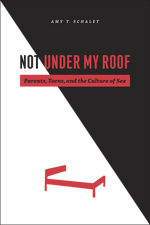 Required reading for 21st Century Parents Don’t let their ignorance of mechanics distract you from the bigger picture: Too many t(w)eens seem to view sexual contact as a casual activity with no serious relationship or emotional closeness required. I fear those kids will have trouble developing bonds of real intimacy.
Last week’s Glee episode featured two in-love high school couples (one gay, one straight – all four teens were 12th graders), crossing the threshold in their long-term relationship and choosing to have sex for “The First Time.” Kudos to the writers for showing us characters sensitive to each other’s needs. Rarely on TV or in films do we see teens willing to put so much careful thought into decisions having to do with sex.
It got me thinking how American teens might make different choices if they had more role models for talking about sex with their partners… or even with their parents.
I know it sounds totally crazy to imagine teens having real conversations with their parents about serious relationships, but after reading Amy Schalet’s new book Not Under My Roof: Parents, Teens and the Culture of Sex I learned the American way isn’t the only way. If we can agree the goal is to prevent teen pregnancy and to help older teens “navigate the challenges of sexuality and first relationships” then, generally speaking, American parents and educators are doing a lousy job.
As Schalet’s book thoroughly documents, Dutch parents have a more open attitude about sex education which results in Dutch teens having less casual sex and far fewer pregnancies. They also sneak around less and experience much less alienation from their parents during these years. Wow! I didn’t know there was an alternative to teen alienation. My view is tainted by emails from teens who don’t like lying to their parents and aren’t particularly enjoying random hook-ups or “friends with benefits” arrangements. Bottom line, they don’t seem to be having all that much fun doing the stuff they’re sneaking off to do and yet, they’re doing it anyway and not necessarily learning anything positive.
I was eager to talk to the Amy about Not Under My Roof. We had a great conversation which included many eye-openers. Check this out: When asked about their first sexual experience, a majority of American girls said: “I wish I had waited longer.” That indicates regret for whatever reason. There’s also a possibility that the girls felt pressured to have sex when they didn’t really want to. When Dutch girls were asked a similar question, 85% said: “We both wanted it. We chose it.”
Very interesting.
Here are my big takeaways from my conversation with Amy Schalet, “One narrative doesn’t fit all.” When we give our teens only one message we:
- Fail to give them the education/guidance/space they need to make responsible choices about their own sexual behavior.
- Build unnecessary walls between us and our kids based on deception and distrust and the false assumption that we can control their behavior.
- Prevent them from a basic understanding of what it means to “be ready” to have sex. This is something only the individual can determine but the parent can help with these guidelines:
- the partner is trustworthy
- the time you’ve had in the relationship thus far
- you and your partner have talked about having sex and what crossing that threshold means to each of you
- you both want to have sex
- you understand it will change the relationship. You’ve thought about and talked about how might it change your feelings for each other. How might it also change your expectations, your behavior, your agreements?
Some of you may feel that teen sex is never ok. If so, then you’re in agreement with the American cultural narrative of “Just don’t do it.” Even if that is your perspective, the teens in your life will still benefit from your talking with them about sex and relationships. They’ll also appreciate your listening to what they have to say. They need to hear your values because by 19 years of age, 70% of young people have had sex. That’s reality. Since that’s where they’re going, you want them making conscious, healthy choices.
btw, in addition to reading Amy’s book, you might also want to check out my interview on FoxNews.com where I talk about Teen Sex in the Family Home.
 — Older Posts »
| |





